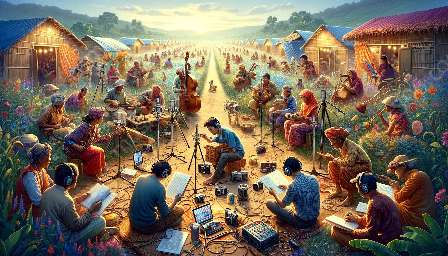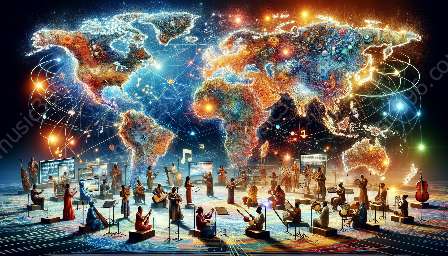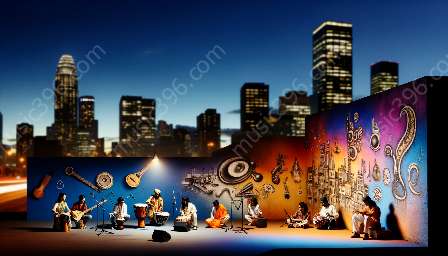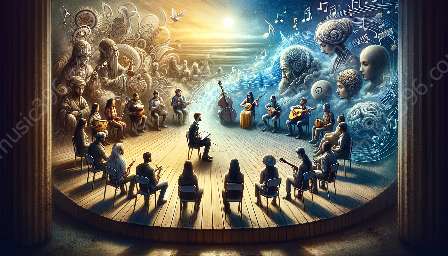Music has been intertwined with altered states of consciousness throughout history, playing a significant role in various cultural and ritual practices. From the rhythmic drumming of indigenous tribes to the repetitive beats in electronic dance music, music has the power to induce trance and alter the mind.
Ethnomusicology: Understanding the Cultural Context
Ethnomusicology is the study of music as a product of and contributor to culture. By examining trance and altered states of consciousness in music-related practices through an ethnomusicological lens, we can understand how different cultural contexts shape musical experiences and perceptions of consciousness.
One key aspect of ethnomusicology is the recognition that music is not solely a form of entertainment, but an integral part of social and communal life. Trance-inducing music is often tied to religious and spiritual ceremonies, healing rituals, and shamanic practices. These rituals vary significantly across cultures, highlighting the diverse ways in which music can be used to change consciousness.
Psychoanalysis: Exploring the Psychological Impact
Psychoanalysis delves into the unconscious mind and explores how music can influence psychological states. From a psychoanalytic perspective, trance and altered states of consciousness in music-related practices are seen as manifestations of the subconscious and collective psyche. Music becomes a vehicle for expressing and understanding the depths of the human mind.
Sigmund Freud, the father of psychoanalysis, highlighted the significance of music in tapping into repressed emotions and desires. This perspective invites us to explore how music connects with unconscious processes and triggers emotional responses that contribute to altered states of consciousness.
Integration of Ethnomusicology and Psychoanalysis: Unveiling the Depths of Music-Induced Trance
When we integrate ethnomusicology and psychoanalysis in examining trance and altered states of consciousness in music, we gain a multifaceted understanding of the interplay between cultural context, psychological processes, and musical experiences.
By studying diverse musical traditions and practices through an ethnomusicological lens, we can appreciate the cultural specificity of trance-inducing music and its relationship to altered states of consciousness. Moreover, psychoanalytic insights allow us to delve into the psychological underpinnings of music-induced trance, unraveling the intricate connections between music, the mind, and the unconscious.
Impact of Cultural Context on Music and Altered States of Consciousness
Cultural context significantly shapes the ways in which music influences altered states of consciousness. Ethnomusicological research reveals how specific cultural beliefs, rituals, and social structures impact the use of music to induce trance. For example, in some indigenous cultures, repetitive drumming patterns and vocal chants form the backdrop for shamanic journeys, creating a communal trance experience deeply rooted in spiritual traditions.
Conversely, in the contemporary context, electronic dance music (EDM) events showcase how music, combined with lighting and visual effects, can trigger altered states of consciousness within the nightclub culture. This illustrates how cultural context evolves and influences the ways in which music fosters trance and altered states of consciousness.
Music as a Tool for Emotional Expression and Catharsis
Psychoanalytic perspectives shed light on how music becomes a medium for emotional expression and catharsis, furthering the understanding of altered states of consciousness. The rhythmic elements and sonic qualities of music have the potential to evoke deep-seated emotions and memories, leading to trance-like states where individuals may experience a release of repressed feelings or a sense of transcendence.
Furthermore, the interplay between lyrics, melodies, and harmonies in music can facilitate communication with the unconscious, allowing individuals to tap into their innermost thoughts and emotions. This integration of ethnomusicological and psychoanalytic perspectives underscores the transformative power of music as a channel for emotional exploration and transformation.
Conclusion
The exploration of trance and altered states of consciousness in music-related practices from a psychoanalytic perspective, integrated with ethnomusicology, reveals the profound connections between music, culture, and the mind. By recognizing the impact of cultural context on music and its psychological effects, this interdisciplinary approach provides a rich and comprehensive understanding of the intricate relationship between music, trance, and altered states of consciousness.



































